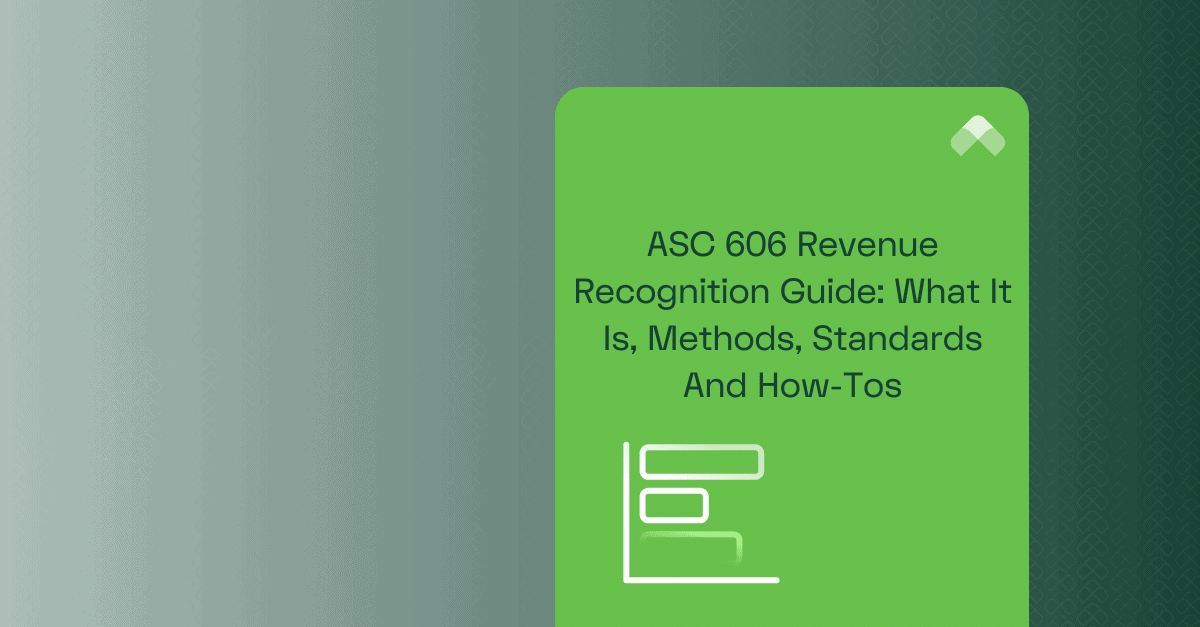Initially, tracking revenue might seem—dare we say—relatively simple. But as a company grows, or even when we compare businesses between different industries, determining when to recognize revenue can become downright tricky. Throw in different pricing models, new revenue streams, the complications of a subscription-based service (like change orders, prorations, upgrades, and cancelations), and/or an increase in the volume of transactions at some point, and things can get complicated fast.
Enter ASC 606 revenue recognition, a set of accounting standards developed by the U.S. Financial Accounting Standards Board (FASB) that aims to standardize how companies should recognize revenue. (Thank goodness.) Now businesses and investors have more clarity around revenue reporting and exactly how to measure their performance obligations over time.
This comprehensive guide will dive into all the particulars of ASC 606, the various revenue recognition methods, and the five steps that FASB recommends companies follow, in addition to industry-specific standards and requirements. We know you just can’t wait, so buckle your seatbelt, and let’s get started!
What Is Revenue Recognition?
In simple terms, it’s an important accounting principle that explains how and when a company should record or recognize revenue (income) in its financial statements from its business activities.
When it comes to recognizing revenue, accuracy and timing matter significantly. This impacts a company’s financial performance and the transparency and consistency of its financial reporting.
The concept of a performance obligation, or a company’s promise to deliver a specific product or service to its customer, is central to revenue recognition. The cash flows arising from a performance obligation must be recorded following FASB guidance, along with certain disclosures in financial statements that detail the nature, amount, and timing of revenues from contracts with customers.
What Is ASC 606 and Why Does it Matter?
Realizing just how convoluted and confusing revenue recognition can quickly become for companies and readers of financial statements alike, in 2014, the U.S. Financial Accounting Standards Board (FASB) and International Accounting Standards Board (IASB) jointly responded by issuing Accounting Standards Codification (ASC) 606. In essence, ASC 606 gives businesses a standardized framework explaining how they should recognize revenue from customer sales.
More specifically, the ASC 606 revenue recognition standard impacts both public and private (nonprofit and for-profit) companies that establish sales agreements or contracts with their customers. In other words, any business that sells goods or services must strive to achieve ASC compliance and abide by these financial reporting standards.
It’s important to note that ASC 606 applies to U.S. companies while similar revenue recognition standard IFRS 15 applies to most non-U.S. jurisdictions. Together, ASC 606 and IFRS 15 standardize how companies across the world should account for revenue. In this way, the U.S.-based Generally Accepted Accounting Principles (GAAP) work with international financial reporting standards.
The FASB and IASB created ASC 606 to achieve several goals:
- To encourage consistency in financial reporting
- To make comparative analysis easier for investors
- To simplify and standardize the preparation of financial statements
Ultimately, ASC 606 replaces a patchwork of industry-specific guidance (ASC 605) to provide a consistent framework for recognizing revenue across various industries and geographical boundaries. It makes financial reporting more consistent, transparent, accurate, and simple.
ASC 606 Revenue Recognition Criteria
When a company enters into a contract with a customer, certain criteria must be met for revenue recognition under ASC 606:
- It is clearly evident that a financial arrangement exists
- The delivery of the product or service is completed
- The customer’s price is measurable and fixed
- The seller can reasonably expect to collect the funds
Note that if a company provides a series of goods or services to a customer over a period of time, it is considered a single performance obligation if the goods and services are essentially the same and have been similarly delivered to the buyer. Also, the cash flows arising from the transaction must be substantial enough to impact the business commercially to fit into the above criteria.
Methods of Revenue Recognition Under ASC 606
There are multiple revenue recognition methods available to companies under ASC 606. By understanding these, businesses can ensure their practices are both accurate and compliant with the relevant regulations. We discuss some of these in more detail below.
Sales-Basis Method
In this instance, revenue is recognized at the time of the sale (in other words, when the goods or services are transferred to the customer). Retailers frequently use this method since their transactions are straightforward and instantaneous.
Completed-Contract Method
Rather than revenue recognized at the time of the sale (like in the sales-basis method above), in this case, it is recorded at the end of customer contracts after all obligations have been fulfilled. Many kinds of service providers use a fixed-fee pricing model. Some examples might include tax preparers, contractors, law firms, and website designers.
Percentage of Completion Method
Commonly used by contractors and engineers because of the length of their contracts, this method recognizes revenue as a percentage of the work completed.
Milestone Method
This method doesn’t recognize profit until all of the project’s expenses have been recouped. Accountants typically use the milestone (or cost-recoverability) method when there is uncertainty around payments (for example, when customers use credit cards or checks to make payments).
Installment Method
Often used when collections aren’t consistent, this method records proportionate profit once an installment is received. It is commonly used in the construction, real estate, and machinery manufacturing industries when customer payments can take a long time, even years, to come in.
Accrual Method
This method is frequently used to handle deferred revenue, which occurs when a company receives payment from a customer for goods or services that haven’t yet been delivered or performed. Instead of recognizing the entire payment as revenue at the time of receipt, the company records it as a liability on the balance sheet. It gradually recognizes the revenue as the goods are delivered or the services are provided over time.
Outside of the above methods, other ways companies can recognize revenue include appreciation, deposit, brokerage agreement, proportional performance, and transactions under bill and hold. There are advantages and disadvantages to every method. Your business can choose to use the one that works best for its individual set of circumstances.
What Are the 5 Steps for ASC 606 Revenue Recognition?
Now we come to the meat and potatoes of this topic—the 5 steps for recognizing revenue. As a reminder, these steps provide a framework for companies to follow as they record revenue on their financial statements according to established accounting standards or by partnering with a service like RightRev to automate revenue recognition.
Let’s jump in below and explore each step in more detail.
Step 1: Identify Customer Contracts
To start, a business must meet certain criteria to show it has entered into a contract with a customer to deliver its goods or services. According to ASC 606, the contract must contain the following components:
- Both parties must approve the contract (this counts if it’s done verbally, in writing, or according to another customary business practice) and plan to perform their agreed-upon obligations
- Both parties must identify and understand the other’s rights in the transaction.
- Both parties must identify the payment terms established for transferring the goods or services
- The seller must expect to collect payment for the goods or services it transfers to the customer
- The transaction must be substantial enough to impact the business’s future cash flows
Let’s briefly walk through an example to illustrate this step.
A software company sells annual subscriptions to its cloud-based project management software. Customer ABC wants to purchase a software subscription.
The company and Customer ABC engage in negotiations and agree on the terms of the software subscription. The terms include the software subscription, with a total cost of $10,000, and the implementation services included in the total cost.
Additionally, both parties sign a formal agreement outlining the subscription terms. This agreement confirms both parties have committed to their obligations.
Since the company and Customer ABC have mutually agreed upon the terms, including the software features, price, and payment, and both parties have committed to the agreement by signing it, a valid contract exists between them, satisfying Step 1 of the ASC 606 revenue recognition practices.
Step 2: Identify the Performance Obligations in the Contract
Next, within the contract, the company must pinpoint each distinct performance obligation or promise it has made regarding delivering a product or service to the buyer. Each obligation is considered distinct when it stands alone, provides value to the customer, and can be transferred from other goods and services mentioned in the contract.
To put it another way, performance obligations are the individual elements that make up the promised goods or services in the contract.
Let’s continue with the example from above to showcase this specific revenue recognition principle. Now the company needs to identify the distinct goods or services it has promised to deliver to Customer ABC as part of the software subscription contract.
It’s evident that the primary performance obligation is granting Customer ABC access to its cloud-based project management software, which allows the buyer to use and benefit from its features. However, the company also offers customer support to assist Customer ABC with any technical issues related to the software during the subscription period. In addition, there are software implementation services as part of the contract.
Ultimately, the two performance obligations outlined in the contract include access to the cloud-based software (customer support is included in the cloud-based software performance obligation) and implementation services.
Step 3: Determine the Transaction Price
Now we come to Step 3, which involves calculating the transaction price, including the cash and non-cash compensation the customer will pay the seller as spelled out in the contract. Discounts, rebates, upgrades, refunds, credits, prorations, and customized pricing (known as variable consideration) must all be factored in here.
This is where things can get really confusing. Despite the importance of this part of the process, determining and allocating the transaction price (Steps 3 and 4) is typically extremely tedious. Performed manually, it’s unfortunately very easy to make errors. Thankfully, services like RightRev that automate the revenue recognition process eliminate this frustration for accountants and significantly reduce the headaches associated with it.
To continue our example, the company must determine the total consideration (transaction price) it expects to receive from Customer ABC for fulfilling the performance obligations identified in Step 2.
In this case, the transaction price is relatively straightforward – $10,000 for the contract, which includes the cloud-based software subscription, customer support, and implementation services.
Step 4: Allocate Transaction Price to Performance Obligations
This step requires companies to allocate the total transaction price across various performance obligations.
It might be easiest to illustrate this step with our ongoing example.
Since the company from our example only has one fixed transaction price component (the annual subscription fee), the entire transaction price of $10,000 is distributed to the identified performance obligations as follows:
- Access to Cloud-Based Software: $6,000
- Customer Support: Included in the access to software
- Implementation Services: $4,000
The transaction price for the package deal is $10,000. The standalone selling prices are estimated at $6,000 for the software license and $4,000 for the implementation service.
To sum it up:
- Identify the Performance Obligations: The company identifies two performance obligations: the software license and the implementation service.
- Determine the Transaction Price: The total transaction price is $10,000.
- Allocate the Transaction Price: The company needs to allocate the transaction price to the two performance obligations: software license and implementation service.
Here’s how it would allocate the transaction price.
Software License:
Standalone Selling Price: $6,000
Allocation Percentage: $6,000 / $10,000 = 60%
Allocated Amount: $10,000 * 60% = $6,000
*It is common for bundled pricing to be discounted compared to the standalone selling price, but to keep our example clean and easy, the standalone selling price and the transaction price are equal.
Implementation Services
Standalone Selling Price: $4,000
Allocation Percentage: $4,000 / $10,000 = 40%
Allocated Amount: $10,000 * 40% = $4,000
Step 5: Recognize Revenue When the Entity Satisfies a Performance Obligation
The final step in the process specifies that revenue will be recognized after each performance obligation is met—not when the contract is started, or the payment comes in.
Let’s refer to our original example one more time.
In this step, the company needs to determine when it should recognize revenue for each of its identified performance obligations based on the progress of fulfilling those obligations. Since access to the software is available immediately upon signing the contract, the company can begin recognizing revenue ratably in alignment with the subscription term. For this example, the contract term is one year (12 months), so 1/12th of the allocated price can be recognized per month. The company can recognize revenue for the implementation services as the work is completed, which in this example is set to occur by the end of Month 1. (see the table below).
| Rev Contract Line | Month 1 | Month 2 | Month 3 | Month 4 | Month 5 | Month 6 | Month 7 | Month 8 | Month 9 | Month 10 | Month 11 | Month 12 | |
| Services | 4,000 | 4,000 | |||||||||||
| Software | 500 | 500 | 500 | 500 | 500 | 500 | 500 | 500 | 500 | 500 | 500 | 500 | 6,000 |
| Total | 10,000 |
Putting it all together, revenue recognized after Month 1 is $4,500 ($4,000 in services and $500 in cloud-based software), while revenue for the remaining performance obligations (cloud-based software) is recognized ratably over the subscription term.
Standards and Requirements Under ASC 606
In wrapping up this comprehensive guide on ASC 606, let’s delve into industry-specific considerations, outline the disclosure requirements for financial statements, and briefly compare ASC 606 to its predecessor ASC 605.
Due to the unique nature of different sectors, some variations can arise.
Here are a few examples:
- Software and Technology Industry: Companies in this industry often have complex revenue arrangements involving licenses, subscriptions, and services. Industry-specific considerations include determining whether to recognize revenue at a point in or over time, allocating transaction prices to various performance obligations, and accounting for upfront fees.
- Construction Industry: Construction contracts can span long periods and involve various stages of completion. Industry-specific challenges often include estimating project completion, recognizing revenue as milestones are met, addressing variable contract terms, and accounting for changes in contract scope.
- Subscription-Based Services Industry: Companies offering subscription-based services need to manage revenue recognition over time as customers consume the services. Challenges involve assessing the nature of the services provided, measuring progress toward satisfying performance obligations, and addressing contract modifications.
- Telecommunications Industry: Telecommunication companies often bundle products and services like phones and plans. They need to allocate revenue appropriately between the products and services, account for equipment upgrades or exchanges, and recognize revenue based on customer usage patterns.
- Healthcare Industry: Healthcare organizations deal with complex billing arrangements and may need to consider factors like insurance reimbursements, co-payments, and deductibles. Patient visits, services provided, and insurance agreements can influence determining when revenue should be recognized.
When it comes to the disclosure requirements for financial statements, there are two types: quantitative and qualitative.
Some of the quantitative components that must be disclosed include:
- Disaggregation of Revenue: Companies should disclose revenue by major product lines, geographical regions, and other relevant segments.
- Contract Balances: Businesses should disclose the opening and closing balances of contract assets and liabilities.
- Unsatisfied Performance Obligations: Companies should explain why some performance obligations were left unsatisfied during the reporting period.
- Significant Payment Terms: Finally, businesses should describe variable consideration or financing in their contracts.
Some qualitative disclosures that should be included include descriptions of performance obligations and their relation to the transaction price allocation methods used, significant judgments made when determining the transaction price, contract modifications, and factors that have affected the timing of satisfying performance obligations.
Finally, it’s interesting to note that ASC 606 replaced the previous revenue recognition standard, ASC 605, to provide a more comprehensive and consistent framework for revenue recognition across industries. ASC 605 was rule-based and relied on industry-specific guidance. It primarily considered risks and rewards, leading to varied revenue recognition practices.
In contrast, ASC 606 is a more principles-based approach that focuses on identifying performance obligations, measuring progress towards completion, and recognizing revenue when control is transferred to the customer. It emphasizes a five-step model and aligns recognition with the satisfaction of obligations.
Revenue Recognition With RightRev
Given all the complexities and variations surrounding how companies receive and recognize revenue, there was likely a global sigh of relief when FASB and IASB replaced ASC 605 in 2014 with ASC 606 and its IFRS 15 counterpart.
Despite all the industry-specific differences that still exist, ASC 606’s five-step revenue recognition framework standardizes the process for all companies, ultimately improving the accuracy, transparency, and consistency of financial reporting across the world (AND making things a heckuva lot easier for all those corporate accounting teams out there). It’s absolutely critical that all businesses fully comprehend ASC 606 and its many intricacies and stay abreast of new accounting standards as they are introduced.
Eliminate all these concerns today by partnering with an ASC 606-compliant service like RightRev that specializes in automating revenue recognition, so you don’t have to worry about it. Contact us to learn more!




